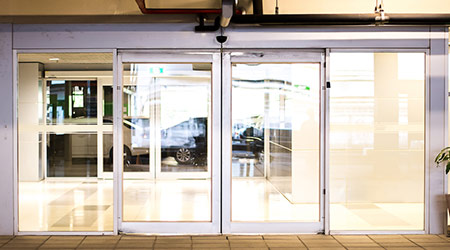Q: Someone just asked me a question and I haven’t thought about this one before. This AHJ is enforcing the IBC but I’m looking for an NFPA viewpoint and of course I thought of you. The IBC and the LSC both require corridor doors in a health care facility to latch. But what if those doors are horizontal sliding doors (manually-operated)? The IBC allows horizontal sliding doors if the space served by the door has an occupant load of 10 or less. The doors in question are not in suites. I don’t see anything that prevents the use of horizontal sliding doors, or anything that says these doors don’t need to latch, but why should they have to latch since they aren’t affected by pressure the same way a swinging door would be? It seems like latching hardware on horizontal sliding doors would be a pain for hospital staff. Have you ever run into this?
A: Yes… I see this issue a lot in hospitals. Many architects are mistaken when it comes to glass sliding doors. Perhaps they follow IBC and specify non-latching doors, but then they fail to comply with the 2012 Life Safety Code, which gets them (and the hospital) in hot water.
Section 19.2.2.2.10.2 discusses horizontal sliding doors that serve an occupant load of fewer than 10 people have to meet all of the requirements in the sub-headings 1 – 5. Sub-heading 5 says where corridor doors are required to latch, the doors are equipped with a latch or other mechanism that ensures the door will not rebound into a partially open position if forcefully closed.
So, the LSC is clear: Where corridor doors are required to latch, the horizontal sliding doors must also latch.
Yes… there are a lot of requirements in the LSC that are a pain to staff. But patient safety is a job that all have to work for, regardless how inconvenient it may be.
Brad Keyes, CHSP, is the owner of KEYES Life Safety Compliance, and his expertise is in the management of the Life Safety Program, including the Environment of Care and Emergency Management programs.

 Making the Energy Efficiency Case to the C-Suite
Making the Energy Efficiency Case to the C-Suite How to Avoid HAIs This Flu Season
How to Avoid HAIs This Flu Season Design Phase Set to Begin for Hospital Annex at SUNY Upstate Medical
Design Phase Set to Begin for Hospital Annex at SUNY Upstate Medical Building Hospital Resilience in an Era of Extreme Weather
Building Hospital Resilience in an Era of Extreme Weather Ennoble Care Falls Victim to Data Breach
Ennoble Care Falls Victim to Data Breach